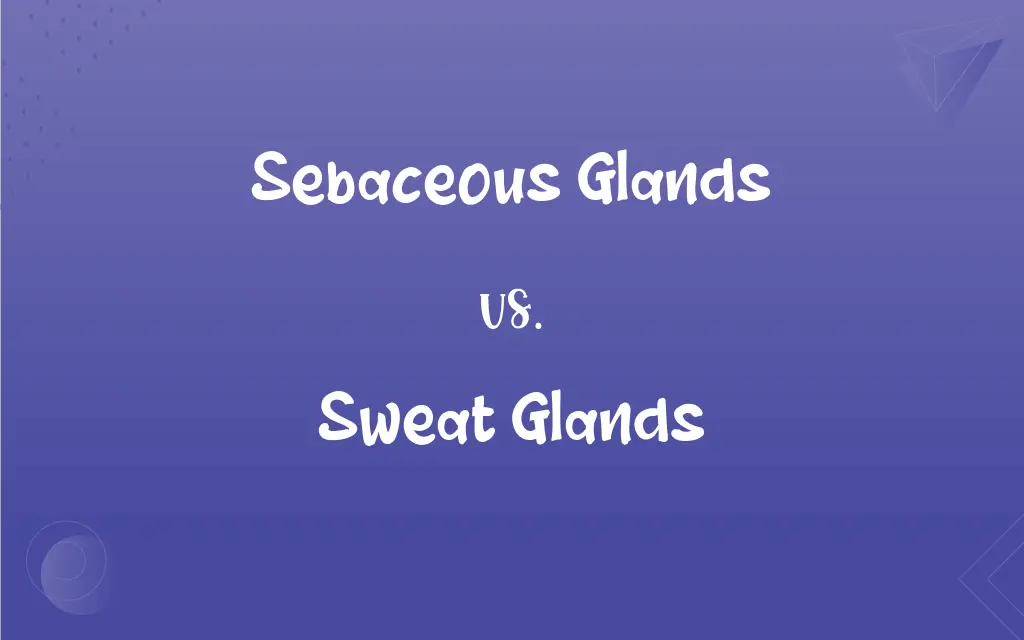Sebaceous Glands vs. Sweat Glands: What's the Difference?
Edited by Aimie Carlson || By Harlon Moss || Updated on October 28, 2023
Sebaceous glands produce sebum (oil) to lubricate the skin and hair, while sweat glands produce sweat to regulate body temperature.

Key Differences
Sebaceous glands are found in the skin and are responsible for producing sebum, an oily substance. Sweat glands, on the other hand, produce sweat which primarily aids in thermoregulation.
Sebaceous glands are predominantly found associated with hair follicles, releasing sebum onto the hair and skin surface. Conversely, sweat glands open directly onto the skin’s surface or into hair follicles.
The secretion from sebaceous glands, sebum, helps maintain skin and hair moisturized. In contrast, the primary function of sweat from sweat glands is to cool down the body through evaporation.
When sebaceous glands become overactive or blocked, it can lead to conditions like acne. In contrast, malfunctioning sweat glands can lead to disorders like hyperhidrosis or anhidrosis, where there is excessive or insufficient sweating, respectively.
Both sebaceous glands and sweat glands play crucial roles in skin health. While sebaceous glands contribute to the skin's natural barrier and protection, sweat glands aid in the elimination of toxins and body temperature regulation.
ADVERTISEMENT
Comparison Chart
Primary Secretion
Produce sebum (oil).
Produce sweat.
Location
Associated with hair follicles.
Open onto the skin’s surface or into hair follicles.
Main Function
Lubricate and moisturize skin and hair.
Regulate body temperature through evaporation.
Associated Disorders
Acne due to overactivity or blockage.
Hyperhidrosis or anhidrosis due to malfunction.
Activation
Hormonally regulated, especially during puberty.
Activated by heat, exercise, and emotions.
ADVERTISEMENT
Sebaceous Glands and Sweat Glands Definitions
Sebaceous Glands
Sebaceous glands can become blocked, leading to acne.
When sebaceous glands are overactive, it can result in oily skin.
Sweat Glands
Sweat glands eliminate waste and toxins from the body.
By sweating, sweat glands play a role in detoxifying the system.
Sebaceous Glands
Sebaceous glands are predominantly found on the face and scalp.
The density of sebaceous glands is higher on the forehead and chin.
Sweat Glands
Sweat glands are responsible for producing sweat in the skin.
During a workout, sweat glands work overtime to cool the body down.
Sebaceous Glands
Sebaceous glands are oil-producing glands in the skin.
For healthy skin, it's essential for the sebaceous glands to function properly.
Sweat Glands
Sweat glands can be eccrine or apocrine based on their function and location.
The armpits have a higher concentration of apocrine sweat glands.
Sebaceous Glands
Sebaceous glands release sebum onto hair and skin.
The sebaceous glands ensure the skin remains moisturized by secreting sebum.
Sweat Glands
Sweat glands are activated by various stimuli, including heat and emotions.
When nervous, our sweat glands can produce more sweat.
Sebaceous Glands
Sebaceous glands play a role in skin's natural barrier.
Without sebaceous glands, our skin would be dry and unprotected.
Sweat Glands
Sweat glands help regulate body temperature.
Thanks to sweat glands, the body can manage heat effectively.
FAQs
How do sweat glands help the body?
Sweat glands regulate body temperature by producing sweat.
What happens when sebaceous glands are blocked?
When blocked, sebaceous glands can lead to acne.
Do all animals have sebaceous glands?
No, not all animals have sebaceous glands; their presence varies across species.
Where are sebaceous glands predominantly found?
Sebaceous glands are mainly found associated with hair follicles.
What are the two main types of sweat glands?
The two main types are eccrine and apocrine sweat glands.
What can overactive sebaceous glands lead to?
Overactive sebaceous glands can lead to conditions like acne and oily skin.
Are there more sebaceous glands on certain parts of the body?
Yes, sebaceous glands are more concentrated on the face and scalp.
Do sweat glands produce only water?
No, sweat contains water, salts, and other waste products.
Can sebaceous glands lead to oily skin?
Yes, overactive sebaceous glands can result in oily skin.
What do sebaceous glands produce?
Sebaceous glands produce sebum, an oily substance.
How do sebaceous glands affect hair?
Sebaceous glands produce sebum that moisturizes and protects the hair.
Can sebaceous glands increase in size or number?
Yes, factors like hormonal changes can affect sebaceous gland activity and size.
Are there areas without sweat glands?
Yes, areas like the nail bed, inner ear, and lip margins lack sweat glands.
Do sweat glands have a role in odor production?
Yes, especially apocrine sweat glands, which produce sweat with fats and proteins that bacteria can break down, leading to body odor.
How are sweat glands activated?
Sweat glands are activated by heat, exercise, and emotions.
Can disorders arise from malfunctioning sweat glands?
Yes, disorders like hyperhidrosis (excessive sweating) or anhidrosis (little to no sweating) can occur.
What triggers sweat gland activity?
Physical activity, heat, and emotions can trigger sweat gland activity.
Is sweating the only function of sweat glands?
While the primary function is cooling, sweat glands also help in waste elimination.
Can sweat glands help in detoxification?
Yes, sweat glands assist in eliminating toxins through sweat.
Why are sebaceous glands important for the skin?
Sebaceous glands keep the skin moisturized and form a protective barrier.
About Author
Written by
Harlon MossHarlon is a seasoned quality moderator and accomplished content writer for Difference Wiki. An alumnus of the prestigious University of California, he earned his degree in Computer Science. Leveraging his academic background, Harlon brings a meticulous and informed perspective to his work, ensuring content accuracy and excellence.
Edited by
Aimie CarlsonAimie Carlson, holding a master's degree in English literature, is a fervent English language enthusiast. She lends her writing talents to Difference Wiki, a prominent website that specializes in comparisons, offering readers insightful analyses that both captivate and inform.
































































